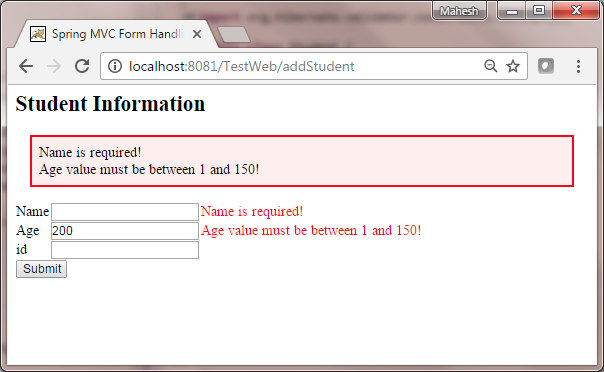以下内容翻译自:https://www.tutorialspoint.com/springmvc/springmvc_hibernate_validator.htm
说明:示例基于Spring MVC 4.1.6。
以下示例显示如何使用Spring Web MVC框架在窗体中使用错误处理和验证程序。首先,让我们使用Eclipse IDE,并按照以下步骤使用Spring Web Framework开发基于动态窗体的Web应用程序:
| 步骤 | 描述 |
|---|---|
| 1 | 创建一个名为TestWeb的项目,在一个包com.tutorialspoint下,如Spring MVC - Hello World Example章节所述。 |
| 2 | 在com.tutorialspoint包下创建一个Java类Student,StudentController和StudentValidator。 |
| 3 | 创建一个视图文件addStudent.jsp,result.jsp中下JSP子文件夹中。 |
| 4 | 下载Hibernate验证程序库Hibernate Validator。提取hibernate-validator-5.3.4.Final.jar和下载的zip文件所需文件夹下所需的依赖项。把它们放在你的CLASSPATH中。 |
| 5 | 在src文件夹下创建一个属性文件messages.properties。 |
| 6 | 最后一步是创建所有源和配置文件的内容并导出应用程序,如下所述。 |
Student.java
package com.tutorialspoint; import org.hibernate.validator.constraints.NotEmpty; import org.hibernate.validator.constraints.Range; public class Student { @Range(min = 1, max = 150) private Integer age; @NotEmpty private String name; private Integer id; public void setAge(Integer age) { this.age = age; } public Integer getAge() { return age; } public void setName(String name) { this.name = name; } public String getName() { return name; } public void setId(Integer id) { this.id = id; } public Integer getId() { return id; } }
StudentController.java
package com.tutorialspoint; import org.springframework.stereotype.Controller; import org.springframework.ui.Model; import org.springframework.validation.BindingResult; import org.springframework.validation.annotation.Validated; import org.springframework.web.bind.annotation.ModelAttribute; import org.springframework.web.bind.annotation.RequestMapping; import org.springframework.web.bind.annotation.RequestMethod; import org.springframework.web.servlet.ModelAndView; @Controller public class StudentController { @RequestMapping(value = "/addStudent", method = RequestMethod.GET) public ModelAndView student() { return new ModelAndView("addStudent", "command", new Student()); } @ModelAttribute("student") public Student createStudentModel() { return new Student(); } @RequestMapping(value = "/addStudent", method = RequestMethod.POST) public String addStudent(@ModelAttribute("student") @Validated Student student, BindingResult bindingResult, Model model) { if (bindingResult.hasErrors()) { return "addStudent"; } model.addAttribute("name", student.getName()); model.addAttribute("age", student.getAge()); model.addAttribute("id", student.getId()); return "result"; } }
messages.properties
NotEmpty.student.name = Name is required!
Range.student.age = Age value must be between 1 and 150!
这里的键值对是<Annotation>.<object-name>.<attribute>,值是要显示的消息。
TestWeb-servlet.xml
<beans xmlns="http://www.springframework.org/schema/beans" xmlns:context="http://www.springframework.org/schema/context" xmlns:mvc="http://www.springframework.org/schema/mvc" xmlns:xsi="http://www.w3.org/2001/XMLSchema-instance" xsi:schemaLocation=" http://www.springframework.org/schema/beans http://www.springframework.org/schema/beans/spring-beans-3.0.xsd http://www.springframework.org/schema/context http://www.springframework.org/schema/context/spring-context-3.0.xsd http://www.springframework.org/schema/mvc http://www.springframework.org/schema/mvc/spring-mvc-3.0.xsd"> <context:component-scan base-package="com.tutorialspoint" /> <mvc:annotation-driven /> <bean class="org.springframework.context.support.ResourceBundleMessageSource" id="messageSource"> <property name="basename" value="messages" /> </bean> <bean class="org.springframework.web.servlet.view.InternalResourceViewResolver"> <property name="prefix" value="/WEB-INF/jsp/" /> <property name="suffix" value=".jsp" /> </bean> </beans>
这里第一个服务方法student(),我们已经在ModelAndView对象中传递了一个空白的Student对象,名称为“command”,因为如果您在JSP中使用<form:form>标签,Spring框架会期望一个名为“command”的对象文件。所以当调用student()方法时,返回addStudent.jsp视图。
将在HelloWeb/addStudent URL 上针对POST方法调用第二个服务方法addStudent()。您将根据提交的信息准备您的模型对象。最后,将从服务方法返回“result”视图,这将导致渲染result.jsp。如果使用验证器生成错误,则返回相同视图“addStudent”,Spring会自动从BindingResult注入错误消息。
addStudent.jsp
<%@taglib uri="http://www.springframework.org/tags/form" prefix="form"%> <html> <head> <title>Spring MVC Form Handling</title> </head> <style> .error { color: #ff0000; } .errorblock { color: #000; background-color: #ffEEEE; border: 3px solid #ff0000; padding: 8px; margin: 16px; } </style> <body> <h2>Student Information</h2> <form:form method="POST" action="/TestWeb/addStudent" commandName="student"> <form:errors path="*" cssClass="errorblock" element="div" /> <table> <tr> <td><form:label path="name">Name</form:label></td> <td><form:input path="name" /></td> <td><form:errors path="name" cssClass="error" /></td> </tr> <tr> <td><form:label path="age">Age</form:label></td> <td><form:input path="age" /></td> <td><form:errors path="age" cssClass="error" /></td> </tr> <tr> <td><form:label path="id">id</form:label></td> <td><form:input path="id" /></td> </tr> <tr> <td colspan="2"> <input type="submit" value="Submit"/> </td> </tr> </table> </form:form> </body> </html>
这里我们使用带有path =“*”的<form:errors />标签来显示错误消息。例如
<form:errors path="*" cssClass="errorblock" element="div" />
它将为所有输入验证提供错误消息。
而且我们使用路径=“name”的<form:errors />标签来显示名称字段的错误消息。例如
<form:errors path="name" cssClass="error" /> <form:errors path="age" cssClass="error" />
它会显示名称和年龄字段验证的错误消息。
result.jsp
<%@taglib uri="http://www.springframework.org/tags/form" prefix="form"%> <html> <head> <title>Spring MVC Form Handling</title> </head> <body> <h2>Submitted Student Information</h2> <table> <tr> <td>Name</td> <td>${name}</td> </tr> <tr> <td>Age</td> <td>${age}</td> </tr> <tr> <td>ID</td> <td>${id}</td> </tr> </table> </body> </html>
完成创建源文件和配置文件后,导出应用程序。右键单击应用程序,然后使用Export > WAR File选项,并将您的HelloWeb.war文件保存在Tomcat的webapps文件夹中。
现在启动您的Tomcat服务器,并确保您可以使用标准浏览器从webapps文件夹访问其他网页。现在尝试URL http://localhost:8080/TestWeb/addStudent,如果输入了无效值,您应该会看到以下结果:

Maven示例:
https://github.com/easonjim/5_java_example/tree/master/springmvc/tutorialspoint/test26